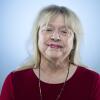Making movie magic
The 43-year-old creative director of Venice-based Gray Matter FX combines real-life imagery and computer graphics to make film magic. Since forming the company with visual effects executive producer Margaux Mackay in 1997, Marshall has been the effects supervisor on “Adaptation,” “Being John Malkovich,” “Fight Club” and the current Johnny Depp thriller, “Secret Window.” In “Secret Window,” Gray Matter created the lengthy opening shot in which the camera travels from a foggy forest lake to the inside of Depp’s cabin, as well as the eerie shot in which Depp’s character confronts himself in the mirror.
The road to visual effects
I graduated [from George Washington University] with a degree in radio and TV production. During that period, I was taking computer science courses and discovered the emerging field of computer graphics. I eventually got a masters in computer science from Pratt Institute in New York. I came out of that saying, “I know how to do computer graphics, so now what do I do with it?” I had at the time the opportunity to see John Lasseter’s [of Pixar Animation] first film. It was amazing. I was floored. I applied and got accepted at USC film school. I fell in love in school with the art of cinematography, and for a while I was considering following that course. When I left school, I did motion control camera [computers controlling cameras] and was shooting a lot of the effects for “Star Trek: The Next Generation.” And then it came full circle back to computer graphics. From there, I progressed up the ladder from doing computer graphics to bringing pieces of the real world together to create shots and scenes and imagery.
Team players
We’re involved in pre-production as much as they allow us to be. We feel that it is the best for us and the best for the production in terms of what they get and how they can control costs. As far as the production, it is best the earlier we get involved in it. ... In the case of “Secret Window” and “Adaptation,” we got involved very early during the pre-production phase. In the case of “Secret Window,” our first meeting was with David Koepp, director of photographer Fred Murphy and producer Ezra Swerdlow. The production had at that point picked out certain key sequences that they wanted to explore with us.
Best-laid plans
The best stunt sequences are very carefully planned to make them look natural, and the same is true with the visual effects. Certainly, you go in with a plan and then you can deviate from it. In the case of “Secret Window,” David Koepp knew very much what he wanted to see. He had paid for a pre-visualization of some of the key sequences, which is a computer-generated storyboard. That is tremendously helpful to us, in that it will give us a very good idea of what it is he likes and what he wants to see. In the opening sequence, while it did modify a little bit, it is startlingly like David’s first vision of it.
Problem-solving
There are two types of problems: the problems that occur prior to shooting and the problems that occur after shooting. It can be very challenging creatively and for the artist working on the computer to fix [a scene] after it has been shot.
The great thing about this job is that it’s never the same thing twice in a row -- you resolving some visual problem, creatively solving that using technical means.
-- Susan King
